I’m in the middle of moving. Indeed, as I’m typing this, I’m taking a break from shifting boxes in the sweltering heat—which always puts me in a mood. I resent owning things, and seeing the accumulation of years in such clear strata makes me feel like an anthropologist picking through the hors d’oeuvres at my own wake.
I wouldn’t be writing articles about Magic: the Gathering if I weren’t a collector, and so moving entails hefting old card catalogues, stacks of bundle boxes, 12” by 12” cubes of vinyl, and box after box of anthologies and old textbooks that I can’t convince myself to toss out. It’s a strange cocktail of nostalgia, frustration, and existentialist panic, which matches in macrocosm the feeling of a new Standard rotation.
That feeling is particularly strong this rotation, as the incoming Midnight Hunt sweeps out sets as far back as October of 2019. Now that Midnight Hunt is rolling out, we’re losing Eldraine (which feels like it’s defined Standard for about five years), Theros Beyond Death, Ikoria, and M21. That’s over a thousand cards, some of which are completely unforgettable.
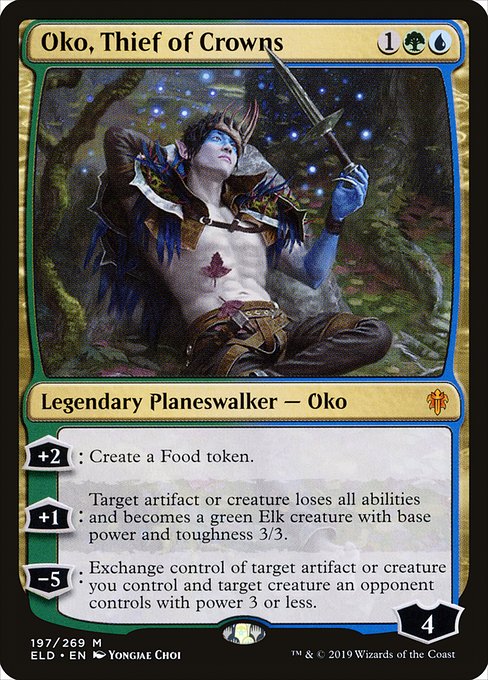
What words can be said over Eldraine’s grave? None, frankly: anything I could say has been said, repeated, repackaged, and regurgitated over the last twenty-four months. The set was pushed in ways we haven’t generally seen post-Mirrodin, and we’ll be dealing with the fallout for some time. Still, the flavor was gorgeous, the Limited format was enjoyable until it got solved, and it gave us a tier of cards just below “in contention for banning” that we’ll be playing for years to come. Quick hits in Eldraine’s twilight:
Embercleave: good riddance. I like Embercleave as a safety valve—can your deck muster enough removal or actuate its own strategy quickly enough to beat a turn four Embercleave? is a fine metric for deckbuilding. But the line of play got incredibly tiresome after a few months, even when you could beat the Embercleave deck. The Cleave did too much for two or three mana, especially when it was trivial to attack with three creatures on turn four. Flash, cost reduction, and automatically equipping meant that Embercleave was destined to overshadow all other Equipment in Standard.
Brazen Borrower/Bonecrusher Giant/Murderous Rider: each gave us a slightly suboptimal spell attached to an aggressive creature, which looks great on paper and plays even better in reality. These were card advantage that gave you a cheap beater, and that extra juice meant these saw consistent play from day one. After the banning of Lucky Clover, the Adventure cards would characterize but not define Standard, so Wizards calibrated these appropriately.
The less said about the banned cards the better—Oko, Uro, and Omnath are thankfully relegated to where they belong in Cubes and Commander decks, while the free stuff squad of Once Upon a Time and Fires of Invention did what free spells tend to do and rode the pine before they rotated out. I don’t want to overemphasize Eldraine’s faults, though—while it was too powerful, the set was refreshing in many ways. Cards like Redcap Melee, Drown in the Loch, Korvold, Rankle, the Castle cycle, Doom Foretold, and Fabled Passage were creatively designed, competitively balanced, and exciting to cast.
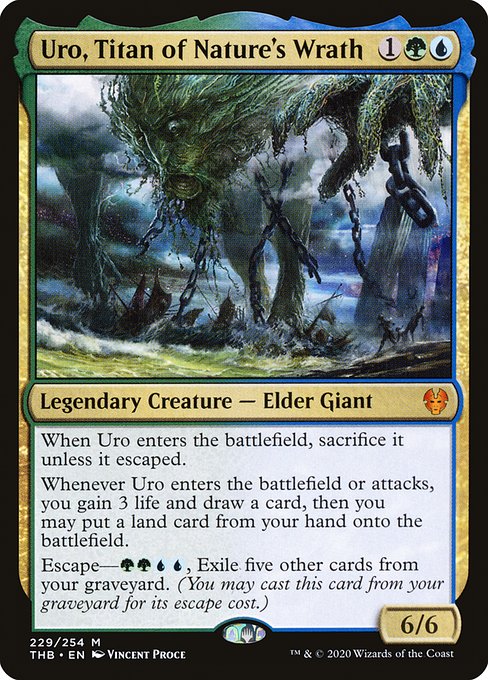
Theros Beyond Death was simply more Theros: more Gods, more Temples, more enchantment creatures, more clunky Limited removal. It was a step down from Eldraine in terms of power, but Uro was just as dominant as any Eldraine card, and especially obnoxious on the heels of Oko. Going from one busted 1UG card to another in the span of a couple of months was demoralizing, particularly when you couldn’t escape the Escaping Titan in Historic or Brawl.
Kroxa, Titan of Death’s Hunger is one of my favorite cards printed in the last few years, and Escape in general is a nice bonus, even if the mechanic was designed very conservatively. Nothing wrong with that—any time you’re messing around with cards that benefit from Dredge-style mechanics and that are inspired by Flashback and Buyback, you’re in dangerous territory, as proven by the Yawgmoth’s Will reboot of Underworld Breach.
Cards that linger—and will continue to see play—from Theros:
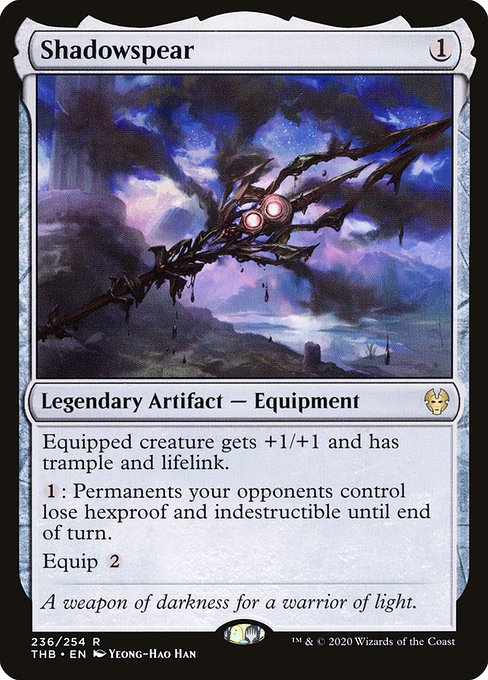
Shadowspear: overshadowed by Embercleave, this little weapon started seeing more play with the release of Modern Horizons 2. All it took was Urza’s Saga to turn this from “back-up Equipment” to “tutorable combat winner.” It’s not a very coherent set of abilities, but players love to build their own Akromas, and the Shadowspear gets you far along that path.
Bronzehide Lion: Back in 2005, Ravnica: City of Guilds brought Watchwolf, which Zvi Mowshowitz (accurately, for the time) described as “bigger than it has any right to be.” Fifteen years later, Watchwolf is thoroughly outclassed, but the Bronzehide Lion still harkens back to the former Selesnya staple.
Mire’s Grasp: Speaking of Ravnican staples, a sorcery speed Last Gasp isn’t anything to write home about. But when it can trigger Constellation, bolster Delirium, and shrink a creature that would otherwise be a big problem, it does just enough to justify itself. Dead Weight is always a delight when it shows up, and its bigger version is even more delightful.
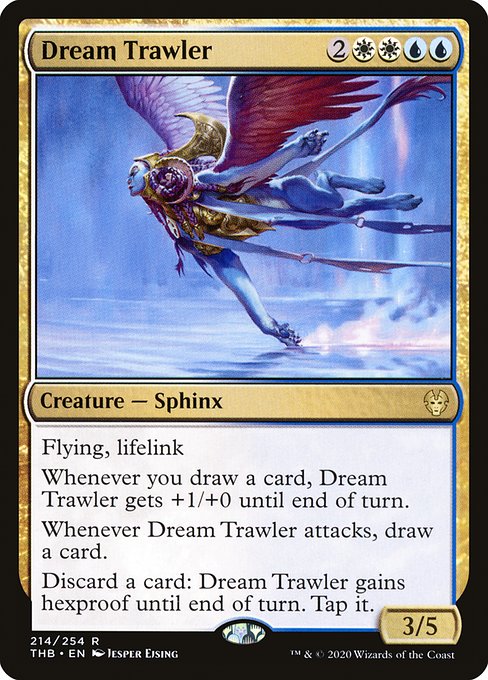
Theros doesn’t get especially high marks; it’s a solid set, but nothing special. My strongest—and least fond—memories of the set are of getting obliterated by Dream Trawler every third draft or so and of having my Pioneer deck (justifiably) banned out from under me thanks to Thassa’s Oracle. I don’t expect to think of it too fondly years from now.
Ikoria really never got its time in the sun—it dropped at the peak of early COVID precautions, and in-store play was completely suspended. The set was something of an also-ran in design: while the promise of magical megafauna was attractive, the Mutate mechanic was apparently unpopular. Mark Rosewater ranks it as a 7 on the Storm Scale—unlikely to return—outside of Ikoria, although all but certain during a return to Ikoria.
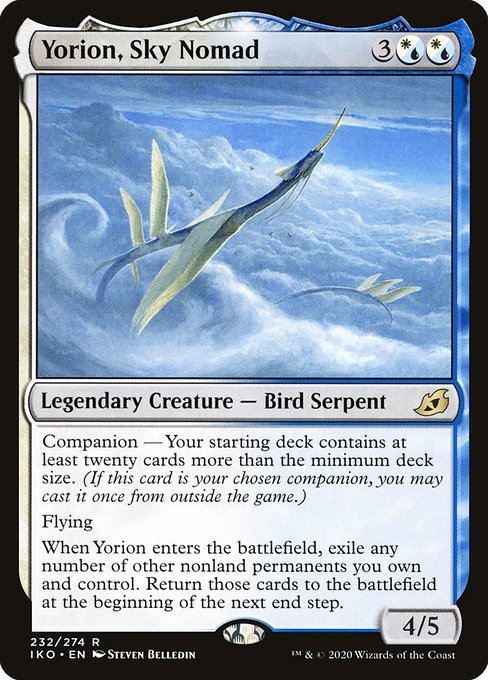
Companion was a massive boondoggle, requiring significant, off-card errata to revert from a broken metagame. Draft was warped by the Cycling deck and Mutate stacks led to misclicks and dropped games. The less said about Lurrus, the better—mostly because I want to keep playing them in Modern, so I want the heat drawn off.
Still, there were gems in the set, including:
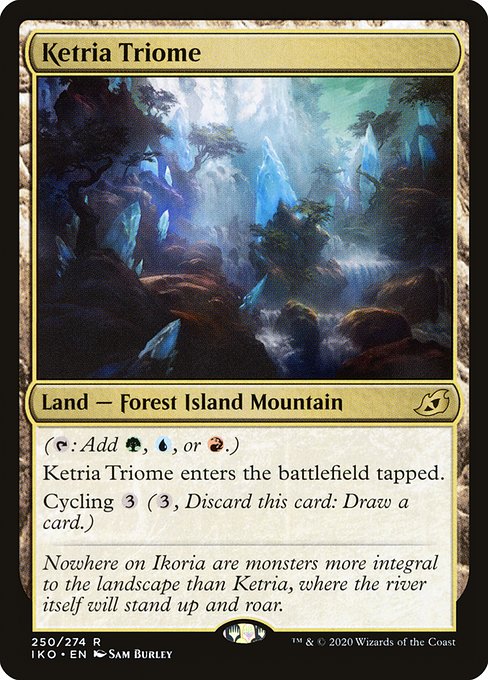
Triomes: Lands that come into play tapped are always discouraging, but Wizards really pushed these to the limits of what’s allowable for a tapland. Shards of Alara gave us simple trichromatic taplands, which were considered fantastic at the time and helped define Standard in conjunction with Reflecting Pool. The upgrades to the Shard lands—that is, the Triomes—not just added Cycling, but are also fetchable and trigger “land type matters” cards. It’s a bold upgrade, and the Triomes were reasonable options without being omnipresent.
Ultimata: While we’re on the subjects of upgrades from Shards of Alara, the Ultimatum cycle is laughably overpowered compared to the originals. Compare Ruinous Ultimatum to Violent Ultimatum, which is like comparing the Wright brothers’ sandhopper to the Lockheed SR-71. Cruel Ultimatum’s bright mirror—Inspired Ultimatum—is, like its Cruel progenitor, a card advantage nuke.
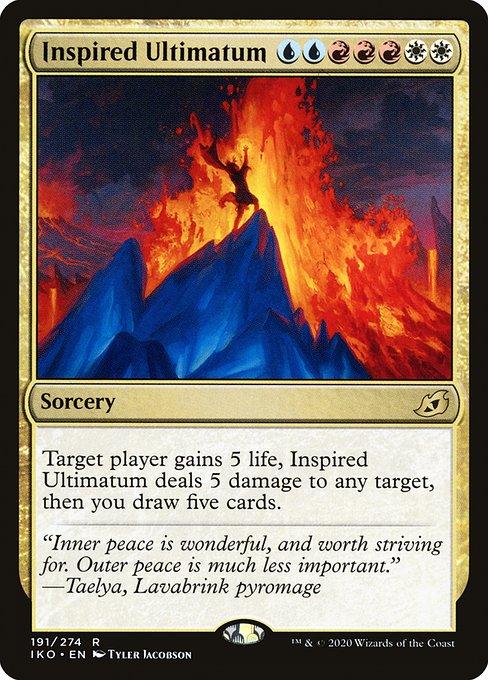
Shark Typhoon: Silliness of the card’s flavor aside, Shark Typhoon is a great synopsis of what Blue is perpetually looking to do. With a Typhoon out, every cantrip is a small flyer, every follow-up cast copy is a flying Titan, and spare copies can be cycled out to ambush attackers.
Hopefully, we’ll never return to the Companion mechanic, although I’d be happy to return to Ikoria itself—the flavor of the set never gelled for me, and I look forward to Mutate being further explored. Probably the easiest layup for those who want to make a little money off Magic is in buying the rarer Mutate cards—once we return to the plane, newer players will need their copies of Nethroi and Gemrazer and especially Souvenir Snatcher.
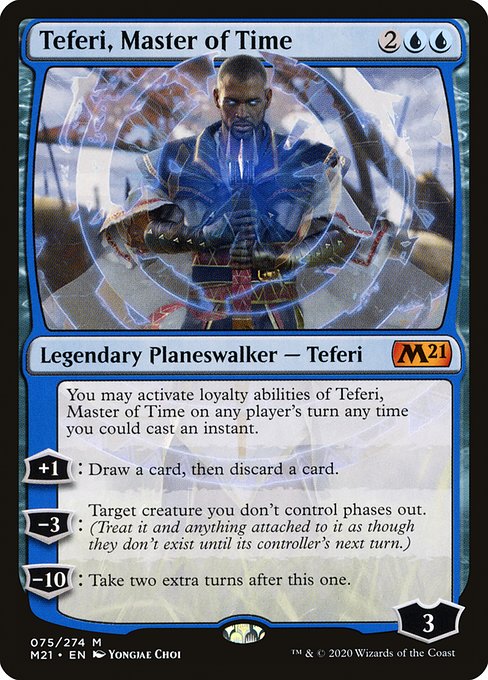
Finally, we’re on the cusp of losing Core Set 2021. I’d call M21 the best Core Set of the last decade. The reprints were hugely exciting and often downshifted in rarity, the limited format was above par for core sets, although still pretty on-rails, and it brought a stack of Standard players that’ll age very well, including Terror of the Peaks, Elder Gargaroth, Containment Priest, and Sublime Epiphany.
You can now get a Grim Tutor for a tenth of its price prior to the reprint and snag a foil Ugin for a fraction of what it once went for. Marketing face card Teferi hit the sweet spot for Standard Planeswalkers, the Mirage flavor was deployed well, and the reprints were, as mentioned, as welcome as they were surprising—from Runed Halo to Scavenging Ooze to Azusa, Lost But Seeking.
Vito, Thorn of the Dusk Rose: Casual staple Sanguine Bond with a body is quite a card, particularly when it can trigger life gain through combat all by itself. Part Defiant Bloodlord and part Whip of Erebos, Vito is a menace.
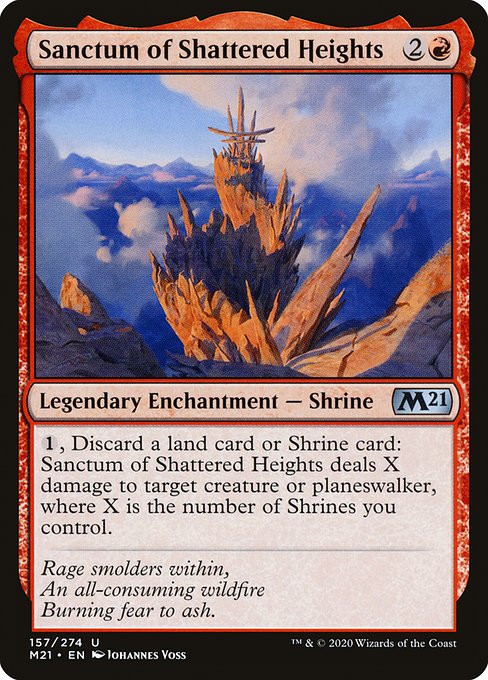
Sanctum of All: One of the greatest aspects of Core Sets is their ability to adapt old sets to new settings. Shrines were once so tied to Kamigawa that I never expected to see them again. Instead, M21 removes the flavor from them completely and, in doing so, allows them to flourish. It’s a beautiful tension—we are familiar with Shrines, but to revisit them, we have to reinvent what we know as Shrines. That’s a quintessentially Magic relationship.
Notably, M21 also shifted “Hounds” to “Dogs” and added more Dogs and Cats. I don’t think it’s controversial to chalk to up to a broader quest for market accessibility—gone are the days of Tolkein-inflected arcana and Stinkdrinker Daredevils in favor of slightly softer and more universal fantasy. Those of us who like the horror and gore of New Phyrexia and Innistrad will always be catered to, but there’s also a place for players who would rather summon Rin and Seri and purchase neon-tinted Secret Lairs. M21 was, with Jumpstart as its tie-in, designed to be an on-ramp for newer players, and what better way to introduce new players than to give them pets instead of Putrid Imps?
This rotation feels pointedly vital—especially after the difficulties of COVID, during which I spent a great deal of time drafting on Arena and jamming best-of-three Standard games. Time, since the spring of 2020, has felt downright gooey, and the sheer amount of reps I got in on Arena during the early stages of the pandemic mean that most of the joy of Embercleaves and Fabled Passages and Teferis has worn off. Signing into Arena this weekend and seeing every Standard deck I’ve built in the last two years flagged with an “illegal cards” warning was equal parts annoying and exhilarating—an “under construction” sign that says change lies ahead.
A lifelong resident of the Carolinas and a graduate of the University of North Carolina, Rob has played Magic since he picked a Darkling Stalker up off the soccer field at summer camp. He works for nonprofits as an educational strategies developer and, in his off-hours, enjoys writing fiction, playing games, and exploring new beers.

